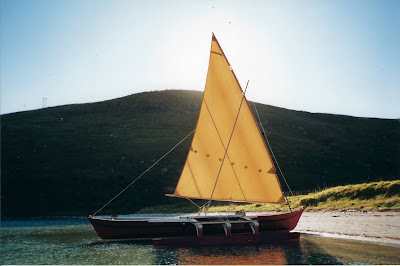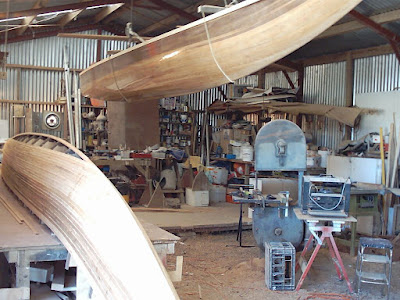The time came to get back to building proas or outriggers. First I had to build another house that was better situated on the harbor waterfront. After completing the house and more commercial jobs I drew up a 31' proa that used some design ideas from the Gilbert Islands (Kiribati).
After sailing Te Wa for some time, I decided to build a smaller 16' proa that would make it easier to experiment with rigs and other parts. Tarawa was the result.
Tarawa was strip planked with local redwood.
The traditional Oceanic crab claw rig.
The experimental Gibbons rig that I came to prefer.
A client wanted a very light custom canoe which I drew up and built from 3mm plywood with light fiberglass over it.
The next project was an 18' classic Hawaiian shaped canoe that I named the Ulua. I strip planked the prototype, paddled it a while, refaired the hull and used it as a plug to produce a female mold. From that set of molds I produced 13 copies made from fiberglass. One was shipped to Canada, one to Hong Kong and one to Rarotonga but the rest stayed in NZ. I drew up plans for the home builder to fabricate it in strip plank and several hundred have since been built.
Fresh out of the mold.
I wanted to sell plans for the Tarawa too but I redrew it longer to 18' and it became the T2.
Paul Sobans T2 is shown below.
I was hired by the Te Toki Voyaging Trust to design and build a 27' tipairua which is a double canoe used in the old days in Tahiti. This was to be a scaled down model of the 75'ers that they have now. I strip planked it in Western red cedar and epoxy glassed it inside and out with a clear finish. The high aspect reefable rig was a modern interpretation of the traditional sail.
Back in my cruising days, I built a second dinghy in the form of a Tahitian paddling canoe. In order to stow it on the deck of my trimaran I had to build it in two pieces. It was a simple flat bottomed shape made of plywood. Wa'apa is the Hawaiian word for a flat bottomed canoe made from three wide planks and so it became the name of my two or three part canoe. Two sections made it 16' and three sections made it 24'. There are now many all over the world.
In this stack of parts is a complete 24' sailing canoe that can be stored in a small area.
I experimented with other rigs and particularly liked the junk rig.
My wife and I decided to have a 3 month stay in Fiji during which time I would build a new outrigger which we could use for fishing and exploring. We found a small cottage on the coast with a hardware store and lumber yard nearby. I shipped a crate ahead with tools, a 2hp outboard and materials that would be harder to find there. Surprisingly it all worked out and the canoe was ready to go in about two weeks. I called the new 20' design the Tamanu after the tree found in the islands that is used for carved canoe hulls. I sold the Tamanu after the three months to our neighbor next door.
Note the round shaped ama made from PVC drain pipe with a carved wooden nose.
I had always had a great admiration for the Tahitian va'a motu, meaning island canoe. The low wave piercing bow, the high stern and a very high aspect sail were all things I wanted to try. Again it was plywood, flat bottomed, leeboard equipped and steered with a rudder. The high aspect rig and big leeboard made it sail upwind with the best.
Hinges in the crossbeams make it quick to set up at the beach.
































Comments
Post a Comment